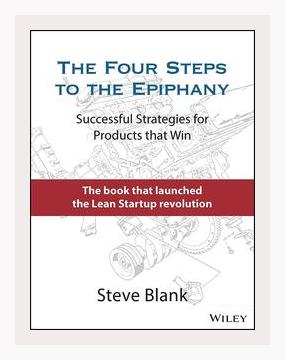Entrepreneurship and StartupsMarket Validation
Introduction:
Steve Blank’s “The Four Steps to the Epiphany” revolutionizes the startup process by introducing the Customer Development Model, a systematic framework for achieving product-market fit by understanding and validating customer needs. The book emphasizes that startups are not smaller versions of large companies and thus require different strategies.
Step 1: Customer Discovery
Objective: The goal of Customer Discovery is to test whether you have identified a problem that customers want to be solved and if your product concept meets this need.
Key Actions:
1. Hypothesize: Develop hypotheses about who your customers are, what problem they face, and how your product can solve it.
– Action: Create detailed personas for your target customer and list their pain points.
2. Test: Conduct interviews and observations to validate or invalidate your hypotheses.
– Action: Schedule face-to-face or virtual meetings with potential customers to discuss their needs and challenges.
3. Learn and Pivot: Based on feedback, refine your product concept or pivot to a different idea if your assumptions were incorrect.
– Example: Blank recounts a tech startup that assumed engineers would adopt a new CAD software easily. Interviews revealed that resistance was due to a steep learning curve, prompting a pivot towards user-friendly features.
– Action: Create detailed reports on customer feedback and adjust your product design accordingly.
Step 2: Customer Validation
Objective: Customer Validation is about developing a repeatable sales process that verifies your business can scale.
Key Actions:
1. Develop a Sales Roadmap: Design a sales roadmap that outlines steps from generating leads to closing sales.
– Action: Map out a clear sales funnel with stages such as lead generation, qualification, and closure.
2. Conduct a Test Sell: Execute small-scale tests to see if you can sell your product in the marketplace repeatedly.
– Example: A startup selling a new type of SaaS product initially sold it to a small group of beta testers. After success, they scaled up their sales efforts.
– Action: Identify a small group of customers to pilot your sales efforts and track conversion rates.
3. Iterate Sales Process: Use feedback from initial sales to refine your approach and materials.
– Action: Collect data on objections and barriers during the sales process and adjust your pitch or product offering to address these concerns.
Step 3: Customer Creation
Objective: Customer Creation focuses on creating and driving end-user demand.
Key Actions:
1. Segment the Market: Identify different market segments and develop strategies tailored to each segment.
– Action: Conduct market research to understand the demographics and psychographics of your potential customer segments.
2. Build Outbound Marketing: Develop and execute outbound marketing strategies to reach your target audience.
– Example: A consumer electronics company used a combination of social media marketing and targeted advertising to generate interest in their product.
– Action: Create marketing campaigns using channels like email, social media, and traditional advertising to promote your product.
3. Leverage Early Adopters: Use your initial customer base as evangelists to promote your product to a broader audience.
– Action: Develop a referral program encouraging early adopters to recommend your product to their networks.
Step 4: Company Building
Objective: Transition from an informal startup to a formal organization that can scale efficiently.
Key Actions:
1. Hire Key Personnel: Recruit specialized staff for roles such as marketing, sales, and operations to scale the business.
– Action: Develop job descriptions based on the skills and experience required to support your growth strategy.
2. Establish Metrics: Implement key performance indicators (KPIs) to measure and manage growth.
– Action: Identify and track metrics such as customer acquisition cost, lifetime value, and churn rate to manage performance.
3. Build Infrastructure: Develop the necessary infrastructure for scaling, including systems for customer relationship management (CRM), finance, and supply chain.
– Example: A logistics startup implemented a sophisticated CRM system to manage their growing customer base.
– Action: Evaluate and implement tools and software that meet your business needs for scalability and efficiency.
Hypothetical Example: Tech Gadget Startup
To illustrate how one might apply these steps, let’s consider a hypothetical startup developing a new tech gadget.
- Customer Discovery:
- Hypothesize that tech-savvy consumers aged 18-35 need a more efficient way to manage their home devices.
- Conduct interviews with tech enthusiasts, and find that the biggest pain point is syncing multiple smart devices.
-
Learn that the proposed solution resonates well, but users require an even simpler interface.
-
Customer Validation:
- Develop a sales roadmap targeting early adopters through tech forums and niche blogs.
- Conduct test sells in local tech meetups and online crowdfunding platforms, resulting in significant interest and initial sales.
-
Iterate sales materials to focus on simplicity and integration features.
-
Customer Creation:
- Segment the market into home automation enthusiasts, digital nomads, and tech hobbyists.
- Execute a marketing campaign through social influencers in the home automation space.
-
Capture referrals and endorsements from the initial user base to drive broader demand.
-
Company Building:
- Hire a marketing manager with experience in consumer electronics and a developer specializing in IoT.
- Establish KPIs to track market penetration and user engagement.
- Scale up operations by implementing a global supply chain management system.
Conclusion:
Steve Blank’s “The Four Steps to the Epiphany” provides a detailed, action-oriented framework for startups to identify and validate their market, create demand, and scale efficiently. By emphasizing real-world application and iterative learning, the book serves as a practical guide for entrepreneurs aiming to build successful products. Following the structured steps of Customer Discovery, Customer Validation, Customer Creation, and Company Building, startups can systematically and effectively bring their products to market and achieve sustainable growth.
